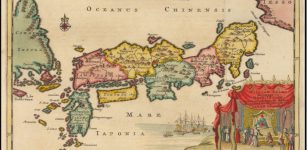Giant Mimir And The Well Of Wisdom In Norse Beliefs
A. Sutherland - AncientPages.com - In Norse mythology, giant Mimir usually appears in the company of Odin, the most powerful and wisest of the gods.
The giant Mimir, however, can easily compete with Odin because he – like the Norns - possesses the wisdom that is not from this world.
Odin Questions Mimir by Carl Emil Doepler, Jr. (1905) Credit: Public Domain
He is the consultant of the gods and knows the secrets of magic runes, and can predict the future. He is the god of knowledge and wisdom and is often called the god of prophecy.
Mimir (in Old Norse: "The Rememberer, The Wise One") is a mysterious figure in Norse beliefs, and it is unclear if he is a god or one of the giants. Three forms of his name are known: Mimi, Mimr, and Mimir, and this name has a strong association with the Latin "memor" – memory, and the Greek: "mermairo" – care.
Mimir is the owner of the Mimir's Well that keeps wisdom and understanding in the world. The well and Mimir's abode are located beneath the second root of Yggdrasil, the World Tree. Mimir guards the well, drinks from it daily, and gains his wisdom from this source. He also feeds Yggdrasil, the sacred tree, daily on the waters from the well.
A Sacrifice In Exchange For A Drink From Mimir's Well
Many visitors come and ask for a drink, but at first, they have to provide a sacrifice of some kind. The god Odin also attempts to access the sacred mead from the well. Mimir is aware of the value of such a favor. He demands a sacrifice in exchange for a drink from the well.
"All right, then I will give you a sip," he says, but it will cost you. The price will be your right eye."
Mimir and Odin by E. Phillip Fleischer (1881). Credit: Public Domain
Whether Odin sacrifices the eye willingly or after some debate is unknown, but in the end, Odin drops his right eye to the well. The eye loss is the price Odin must pay to gain the privilege of drinking from the well.
Why Did Mimir's Head End Up In A Well?
From Norse mythology, we learn that after the war between the Aesir and Vanir, Mimir was sent together with Hoenir to the Vanir gods.
Known as God of Silence and Odin's brother, Hoenir was indecisive and always relied on Mimir to make the decisions. It made the Vanir suspicious and annoyed, so they beheaded Mimir and sent his Head back to Odin and the Aesir.
Odin used his magic to preserve Mimir's Head and often consulted the beheaded god for advice and wisdom. Mimir's Head is the wisest of all heads ever known, but it cannot solve all the problems.
On the day when Fenrir threatens the destruction of the world, the mighty Odin seeks Mimir's advice. Unfortunately, Mimir's Head, the wisest of all heads, cannot help him in this case.
Stories about Mimir are included in the Poetic Edda poems "Völuspá" and "Sigrdrífumál." However, the story about Mimir's Head is narrated only in Snorri Sturluson's "Ynglinga Saga," the first part of "Heimskringla."
Snorri most probably either quoted poems that have not survived in the manuscripts, or he invented this story.
Updated on August 17, 2022
Written by – A. Sutherland AncientPages.com Staff Writer
Copyright © AncientPages.com All rights reserved. This material may not be published, broadcast, rewritten or redistributed in whole or part without the express written permission of AncientPages.com
Expand for referencesReferences:
Brate E. Eddan, De nordiska guda- och hjältesångerna
Baeksted A. Nordiska gudar och hjältar
More From Ancient Pages
-
 Secrets Of Cheops’ Pyramid: Does The Newly Found Chamber Contain An Iron Throne?
Archaeology | Jan 13, 2018
Secrets Of Cheops’ Pyramid: Does The Newly Found Chamber Contain An Iron Throne?
Archaeology | Jan 13, 2018 -
 Mysterious Ancient Underground King And Ruler Of The World – Who Was He? Part 1
Civilizations | Jul 25, 2018
Mysterious Ancient Underground King And Ruler Of The World – Who Was He? Part 1
Civilizations | Jul 25, 2018 -
 Spread Of Transeurasian Languages Was Due To Agriculture Study Reveals
Archaeology | Nov 10, 2021
Spread Of Transeurasian Languages Was Due To Agriculture Study Reveals
Archaeology | Nov 10, 2021 -
 Dancing Around The Throne: Networking In The Time Of King William I
Ancient Traditions And Customs | Jul 4, 2023
Dancing Around The Throne: Networking In The Time Of King William I
Ancient Traditions And Customs | Jul 4, 2023 -
 Nabopolassar: Father Of Nebuchadnezzar II And King Of Babylon Rose To Power Thanks To His Dedication To Gods Nabu And Marduk
Featured Stories | Jan 11, 2019
Nabopolassar: Father Of Nebuchadnezzar II And King Of Babylon Rose To Power Thanks To His Dedication To Gods Nabu And Marduk
Featured Stories | Jan 11, 2019 -
 Secrets Of The Scarab – Ancient Sacred Symbol In Human History
Ancient Symbols | Jun 14, 2015
Secrets Of The Scarab – Ancient Sacred Symbol In Human History
Ancient Symbols | Jun 14, 2015 -
 Unique 1,800-Year-Old Stone Sarcophagus Exposed In Ashkelon Building Site
Civilizations | Sep 6, 2015
Unique 1,800-Year-Old Stone Sarcophagus Exposed In Ashkelon Building Site
Civilizations | Sep 6, 2015 -
 Ancient DNA Reveals: Iberian Males Were Almost Completely Replaced Between 4,500 And 4,000 Years Ago
Archaeology | Mar 15, 2019
Ancient DNA Reveals: Iberian Males Were Almost Completely Replaced Between 4,500 And 4,000 Years Ago
Archaeology | Mar 15, 2019 -
 Visit The Palace Where Alexander The Great Was Born In Pella
Archaeology | Oct 21, 2020
Visit The Palace Where Alexander The Great Was Born In Pella
Archaeology | Oct 21, 2020 -
 Pytheas’s Voyage To The Arctic In 325 B.C. And Account Of Thule, The Strange Land Beyond
Featured Stories | May 29, 2021
Pytheas’s Voyage To The Arctic In 325 B.C. And Account Of Thule, The Strange Land Beyond
Featured Stories | May 29, 2021 -
 9,000-Year-Old Settlement Unearthed Near Jerusalem Sheds New Light On Stone Age Civilization
Archaeology | Jul 17, 2019
9,000-Year-Old Settlement Unearthed Near Jerusalem Sheds New Light On Stone Age Civilization
Archaeology | Jul 17, 2019 -
 Ancient Religious Ceremony May Shed Light On The Mysterious Qumran Site
Archaeology | Sep 6, 2021
Ancient Religious Ceremony May Shed Light On The Mysterious Qumran Site
Archaeology | Sep 6, 2021 -
 Olive Trees Were First Domesticated 7,000 Years Ago In The Jordan Valley
Archaeology | Jun 17, 2022
Olive Trees Were First Domesticated 7,000 Years Ago In The Jordan Valley
Archaeology | Jun 17, 2022 -
 Inchbrayock Stone: Pictish Samson Stone Carved With Biblical Symbols And Scenes
Artifacts | Jan 21, 2019
Inchbrayock Stone: Pictish Samson Stone Carved With Biblical Symbols And Scenes
Artifacts | Jan 21, 2019 -
 Mysterious Death Of Cambyses II – Natural, Suicide Or Assassination By Darius I The Great?
Featured Stories | Apr 21, 2021
Mysterious Death Of Cambyses II – Natural, Suicide Or Assassination By Darius I The Great?
Featured Stories | Apr 21, 2021 -
 Horrifying Flying Head That Terrorized The Iroquois
Featured Stories | Sep 17, 2019
Horrifying Flying Head That Terrorized The Iroquois
Featured Stories | Sep 17, 2019 -
 Halloween: Facts And History About All Hallows’ Eve And Its Connection With Samhain – An Ancient Celtic Festival
Ancient Traditions And Customs | Oct 31, 2021
Halloween: Facts And History About All Hallows’ Eve And Its Connection With Samhain – An Ancient Celtic Festival
Ancient Traditions And Customs | Oct 31, 2021 -
 Were The Viking Berserkers True Or Drug Addicted Warriors Fighting In Trance?
Featured Stories | Feb 3, 2015
Were The Viking Berserkers True Or Drug Addicted Warriors Fighting In Trance?
Featured Stories | Feb 3, 2015 -
 Controversial Ancient Takenouchi Documents Could-Re-Write Our History – Story Of Gods, Lost Continents And Ancient Sages
Featured Stories | Apr 28, 2017
Controversial Ancient Takenouchi Documents Could-Re-Write Our History – Story Of Gods, Lost Continents And Ancient Sages
Featured Stories | Apr 28, 2017 -
 What Can New Method Radiocarbon 3.0 Reveal About The Interaction Between Homo Sapiens And Neanderthals?
Archaeology | Mar 29, 2023
What Can New Method Radiocarbon 3.0 Reveal About The Interaction Between Homo Sapiens And Neanderthals?
Archaeology | Mar 29, 2023


